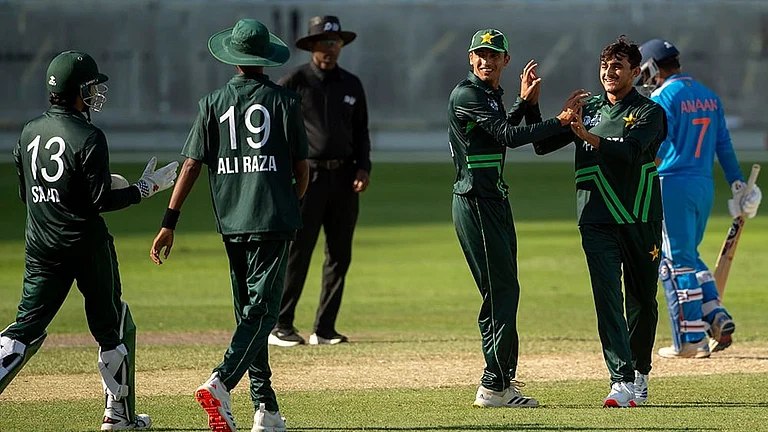Let us get one small detail straight.
The Murali Vijay statement about the BCCI, and how cricketers above 30 are treated in India - a big statement in a landscape where lips are often sealed - was made in the context of Shikhar Dhawan’s one-day chances.
But Vijay’s answer eventually did touch upon his own career, and that of other 30-plus cricketers, save for exceptions like Virat Kohli and Rohit Sharma.
This is what he said to a question asked by former India batsman WV Raman in a video interview. A bit of it was tongue-in-cheek and not as serious as it sounds on paper.
“After 30 in India, it’s a taboo [to pick a player of that age],” said the 38-year-old Test specialist. “I think people see us as 80-year-olds walking on the street. This is how people’s mentality is, or the media is addressing it that way. They should change a little bit. I feel in the 30s you are at the peak. Now [at this age] I feel I can bat the way I can bat. But fortunately or unfortunately the opportunities are less, and I got to search for my opportunities outside. I’m almost done with BCCI and I want to find my ways abroad, and play little bit of competitive cricket.”
Vijay last played a Test for India in 2018, when he was 34. It is clear, therefore, that his form and the rise of other players had as much to do with his chances drying up as age. In any case, with 61 Test matches for India, 3982 runs and 12 centuries, with ODI and IPL appearances, he had a successful career.
Yet, Vijay’s statement was surprising considering this is an era in which players in different sports often play till their 40s. Sachin Tendulkar laid his bat down at 40. MS Dhoni, 41, is still playing the IPL and represented India till his late 30s. Rahul Dravid, too, played till 38. England seamer James Anderson aims to play the 2025-26 Ashes, when he will be 43.
Playing till the 40s or thereabouts is not a recent phenomenon either. Sunil Gavaskar was a grey-haired 37 when he produced one of the greatest knocks of his life, 96 on a rank turner in Bangalore against Pakistan. Geoffrey Boycott could cure insomnia with his dull batting, but his dedication to self-preservation also meant he played till 41, at a time when cricketers did not have the advanced training methods and diets of today.
What is ageing?
But ageing does start at some point. And it can happen without warning. Everything is going fine and then suddenly you start feeling slower, achy and whatnot.
For Rostyn Griffiths, Mumbai City FC’s Australian footballer, it started at 32.
“Thirty-two was the first time I felt different in my body,” Griffiths told Outlook. “Recovering after games or hard gym sessions took longer. And the other big change for me was diet. I realized that I was putting on weight quicker than before. So I had to worry more about what I was eating, what I was drinking.”
Reflexes slow down, vision sometimes gets weaker and players have to work out in the gym judiciously. Another, somewhat lesser-known effect of ageing on an athlete is a decrease in oxygen absorption.
“One big reason we see declines in aerobic (or endurance) athletic performance with age is that our bodies can’t use oxygen as effectively,” Chris Minson, physiology professor at the University of Oregon, once wrote in The Conversation. Further on, he said, “The reason VO2 Max declines with age is that our maximal heart rates go down as well.”
The perception of 30-plus players
There are perks and downs to being the older player in the dressing room. You are looked at with some respect, as long as you have performed. But you are not a part of future plans. Contracts tend to be for a shorter duration too. Decision-makers such as coaches and selectors do see older players a bit differently, feels Griffiths.
“People definitely bring age up a lot [after a player crosses 30],” he says. “There's a greater level of respect shown towards you from coaching staff. Having said that, contract lengths may be a little bit shorter, or things like that, that you didn't have to worry about when you were younger.”
Modifications in exercise and lifestyle are time-tested ways to prolong careers. The seeds of Lionel Messi’s longevity and his 2022 resurgence were sown about a decade ago. His diet at the time was Ron Swanson-like, heavy on red meat, pizza and soft drinks. But there came a time when he would regularly vomit on the field. He got frequently injured too. Messi, then consulted a respected, slightly offbeat Italian doctor named Giuluano Poser. Out went the tasty culprits – the meat, pizza and soda. In came the staid saviors – vegetables, fruits, water – along with talk therapy and Bach Flower remedies.
Griffiths plays in much smaller leagues than Messi. But the process is more or less similar for professionals at any level. Griffiths too started paying closer attention to diet after a certain point in his career.
“I eat a lot less food than I used to,” he says.
Sometimes, old is gold
The value an older player can bring to a team can’t be doubted. After all, it was a 35-year-old Messi, who inspired Argentina to World Cup victory recently.
Some years ago, Ed Smith, the former England cricketer, and then writer and selector, gave an example of how old can prove to be gold. As a child, he had wanted a new bat, and coaxed his father to come to the store. His father, a wise man, carried Ed’s old bat along. Once there, he demonstrated to his son, through drills, that the old bat performed better than the new one.
“We are hardwired to admire novelty,” Smith wrote. “This applies even to selecting cricket teams. International teams often miss out on valuable contributions from experienced players who they have for long passed over or written off. In the rush to find a new brand, we neglect existing stock that could still do the job.”


























